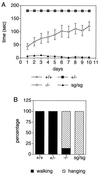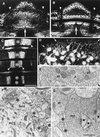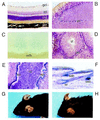staggerer phenotype in retinoid-related orphan receptor alpha-deficient mice
- PMID: 9520475
- PMCID: PMC19945
- DOI: 10.1073/pnas.95.7.3960
staggerer phenotype in retinoid-related orphan receptor alpha-deficient mice
Abstract
Retinoid-related orphan receptor alpha (RORalpha) is a member of the nuclear receptor superfamily. To study its physiological role we generated null-mutant mice by targeted insertion of a lacZ reporter gene encoding the enzyme beta-galactosidase. In heterozygous RORalpha+/- mice we found beta-galactosidase activity, indicative of RORalpha protein expression, confined to the central nervous system, skin and testis. In the central nervous system, the RORalpha gene is expressed in cerebellar Purkinje cells, the thalamus, the suprachiasmatic nuclei, and retinal ganglion cells. In skin, RORalpha is strongly expressed in the hair follicle, the epidermis, and the sebaceous gland. Finally, the peritubular cells of the testis and the epithelial cells of the epididymis also strongly express RORalpha. Recently, it was reported that the ataxic mouse mutant staggerer (sg/sg) is caused by a deletion in the RORalpha gene. The analysis of the cerebellar and the behavioral phenotype of homozygous RORalpha-/- mice proves identity to sg/sg mice. Although the absence of RORalpha causes dramatic developmental effects in the cerebellum, it has no apparent morphological effect on thalamus, hypothalamus, and retina. Similarly, testis and skin of RORalpha-/- mice display a normal phenotype. However, the pelage hair of both sg/sg and RORalpha-/- is significantly less dense and when shaved shows reluctance to regrow.
Figures





References
-
- Becker-André M, André E, DeLamarter J F. Biochem Biophys Res Commun. 1993;194:1371–1379. - PubMed
-
- Giguère V, Tini M, Flock G, Ong E, Evans R M, Otulakowski G. Genes Dev. 1994;8:538–553. - PubMed
-
- Carlberg C, Hooft van Hujisdujinen R, Staple J K, DeLamarter J F, Becker-André M. Mol Endocrinol. 1994;8:757–770. - PubMed
-
- Hirose T, Smith R J, Jetten A M. Biochem Biophys Res Commun. 1994;205:1976–1983. - PubMed
MeSH terms
Substances
LinkOut - more resources
Full Text Sources
Other Literature Sources
Molecular Biology Databases

